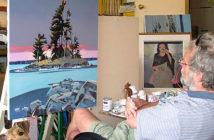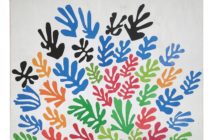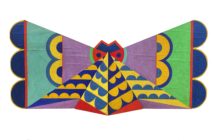Dear Artist,
Among my tropical, under the palapa reading I included Blink, Malcolm Gladwell’s new book on the values and pitfalls of quick and intuitive decision-making. Lots of good stuff here.
For example, the various brands of products such as strawberry jam are subjected to rigid tests by professional tasters. White-coated experts compare a full clipboard of criteria — texture, colour, viscosity, taste, etc. In an additional spin, a bunch of randomly selected college students are asked to give their opinion on the jams. One gulp of each and these folks pretty well duplicate the results of the experts. But that’s not the interesting part. When yet another group is asked to put into writing and to defend their choice of the jams they get them all mixed up. Some of the poorest quality jams come out on top, and some of the best score near the bottom. Psychologists call this phenomenon “verbal overshadowing.” It seems that when we try to put our decisions into words we get into the business of fooling ourselves and muddying the waters.
Artists who jury shows, give crits, or rationalize the marking of their students’ work may have noticed the problem. In one competition we jurors were asked to write a short evaluation of each work entered. I remember watching my fellow jurors squirming in front of work and not being able to say “why.” One guy was into changing his votes. Wisdom prevailed and the keepers and losers were let be. One colleague remarked that this was the reason art schools could be such wastelands. “Art’s a doing thing,” he said.
Gladwell’s book rather promotes the idea that in love and war, in food and art, the quick, intuitive decision, without verbiage, is the one worth heeding. The French call it “coup d’oeil” (power of the glance). Recently I was asked to comment on the authenticity of a newly discovered work by the well-known painter, A. Y. Jackson. As there were fakes about, several white-coated experts had had an inconclusive go at it and the buyer was hesitant. One glance and I knew it was a phony — as it was soon proven to be. I have a fair degree of experience in cruising Jackson’s work. This one looked okay, typical subject matter, on style, correct pigments, the right ground, etc., but it was the wrong “hand.” It was “attempted hand,” not his hand, and that, in a glance, made the difference.
Best regards,
Robert
PS: “Our unconscious is really good at quick decision-making — it often delivers a better answer than more deliberate and exhaustive ways of thinking.” (Malcolm Gladwell)
Esoterica: Gladwell notes that police officers are trained to make quick decisions about when to shoot people. Sometimes they get it wrong. It’s not always good to make quick, visual decisions. Auditions for membership in symphony orchestras have changed over the last thirty years. Candidates are now screened-off from the decision-makers who are also asked to remain silent. The practice of auditioning behind a screen has resulted in a remarkable increase in the hiring of brilliant trombone players who just happen to be women.
Three questions to ask
by Richard Nelson, Kula, HI, USA
If “Art’s a doing thing,” why are you writing all these twice weeklies? For me, the problem begins with jurors who fail to ask three questions, i.e. “What’s the artist trying to do?” “Did he do it?” and “Was it worthwhile doing?”
(Andrew Niculescu note) Robert’s letter My angle is a good start in answering the “why these twice weeklies.” For further reading about jurors and juried art shows, here’s a selection from our Letters Archives: On being casual, High exaltation, Fall fair, Art picking.
Second look revealing
by June Raabe, Ladysmith, BC, Canada
At a recent show I marveled at the winning watercolour, because it was so dull, so boring, and wondered “why” it won — just blue/green/grey and blah! I finally took a close look and realized the washes were flawless, no drizzles, ouzels, backruns, no mud, clear flat (boring) washes. I learned that perfection sways some jurors.
Hesitant to shoot
by Mel Lammers, Fort Worth, TX, USA
As an amateur photographer who is working on getting better, I find that my first decision is often correct but sometimes not. Often my first decision is confirmed correct after it sits for a while. It is kind of a marinating process. If I were trying to decide who to shoot with a gun, I don’t know what I would do.
Interpretation and reception
by Laurie Dematteo, Philadelphia, PA, USA
Interpreting is definitely different from reception. Reception is screened by our perception while interpretation is screened yet once more by the receiver’s personal logos. Interpretation is doubly removed.
Jam-test of words
by Alison Mackie, FL, USA
This verbal overshadowing phenomenon illustrates the power of the written word. And yet, we need a safe place, a reserve of truth, a place where words kindle ideas and set ideas sparking off in others, a word sanctuary. Poetry is this gathering place of words. Once there, we can hear word’s musicality, visualize the images words paint, and feel words. A poet’s words mirror and enhance what is already within us.
When a poet’s words reach into, shake, and inspire our own secret heart of words, we are deepened by the exchange, and the truest power of words — the power to create sensation in others — is realized at its most meaningful. There is no finer jam test of words than poetry.
Doing and delving
by Sue Johnston
While it is true that the glance is incredibly perceptive, I am glad that you acknowledged that the thorough, written response to a piece is also extremely valuable. It could be called the ‘doing thing’ and the ‘delving thing’. Recently I wrote an article on Donald Judd’s sculpture called Untitled, 1974. I felt incredible satisfaction in immersing myself in the paradigm in which this work had been created, even though at first glance it left me cold. Now Donald Judd’s work holds a particular fascination for me.
Combinations of complexity
by Judy Haney, San Francisco, CA, USA
It is so very true that reality often gets lost in writing. As a writer who for twenty-five years has practiced the art of ‘writing what I see simply and clearly,’ I am certainly aware of the work it takes, not only once, but each time I set down to write, to accomplish this art. Yet, in so many ways it is the same. Artists have a color palette with infinite combinations of complexity; writers have words, with infinite combinations of complexity. Truth, in both of these arts, is what my teacher, an ancient sage states, “You must love writing [or art]more than you love yourself.”
Evaluation blocks
by Warren Mangione
Too much evaluation, thinking actually, is what not only muddies the waters but impedes going about choosing a subject, etc. to paint. It actually is blocking taking action, picking up a brush and paints. I just enrolled in a beginner Watercolor course with a man who appeals to the emotions and unconscious. For example, in the first class last week he said, “It’s just a piece of paper.” In a recent email he said, “We’re going to have a lot of fun this week.” He is moving away from evaluation and into the emotional and unconscious. Evaluation, particularly self-evaluation, are blocks to the creative process and to moving into action and creating art.
Lost on jargon
by Brad Greek, Mary Esther, FL, USA
I find it interesting, when attending show openings, to listen to artists describe their work. The art-educated artist shines through within the first sentence, with all kinds of descriptive jargon and some words I’ve never heard of. Which leaves me totally lost on what they are trying to say. The same goes with artists talking in the art forums that think they have to prove their worth by knowledge of, as you say, “verbage.” I have to agree with that one juror who said, “Art is a doing thing.” If I spent that much time trying to figure out what I was trying to paint I would not get any painting done.
Natural impulse
by Nicole Best Rudderham, Prince Rupert, BC, Canada
Children naturally have first impressions, and many of us lose them, or as adult artists search ourselves to retrieve them back. Adults will often think they are doing a good thing ‘assuring the child’ about a bad feeling, or a thought that children just “come up with,” by saying that they are mistaken. Unfortunately we as adults talk them out of it, for the sake of one reason or another, to calm nerves or to find a logical reason for it. Trying to make it verbal changes the whole incident or moment. The confused child then each time doesn’t rely on the thought or “first impression” even though the natural ones are our very own built-in mechanisms for our safety and/or basic instinct.
I think as artists we channel those “impulses” when we create that piece of art that “just happens! — it was feverish! — I just couldn’t stop!” etc. in between the artwork that we “need to work at — to get it done!”
Critical thinking insights
by Martha Greenwald, Winona, MN, USA
While the decisions we make in an intuitive blink can be good ones, e.g. that saucedoesn’t taste quite right, that road looks too congested, I’m attracted to that man — we are good at criticism but not necessarily good at critical thinking.
We can have a critical intuitive response to a person or a work of art. Faster than a blink we reach for our internal grab-box of the labels we attach to something that is different from our taste. A work of art is too abstract, representational, fantastic, colorful or muted. Or, a person we meet is too noisy, materialistic, authoritarian, studious, picky, pushy, wishy-washy, religious, inefficient, or any one of a host of our favorite critical labels.
I once visited the Walker Art Center in Minneapolis to spend time viewing a sculpture. In the same room there were a number of small abstracts by collagist Anne Ryan. In a normal blinking visit to a museum, I would have walked right by these works. As I sat and looked at them for 40 minutes they started to come alive. I fell in love with them.
If Blink is encouraging us to value our intuitive responses, the corrective I would add is urging people to be willing to remain open to things, despite our rapid intuitive reaction. We may surprise ourselves by moving from intuitive criticism to critical thinking, which offers all kinds of potential new insights.
Challenging the rules
by oliver, Houston, TX, USA
When analyzing a piece, one inevitably falls into a rule-based system and particular components are compared to “the rules” for that medium and school. One must use the proper set of rules to judge the piece. For example, it would be wrong to use the “rules” that are used to understand and judge a cubist painting on an impressionist painting.
Some of the best pieces challenge “the rules” or even run exactly counter to the rules, norms and expectations. Sometimes this leads to a new school of art and a new set of rules to judge works. Transitional pieces and artists are sometimes the most difficult to place and understand until many years later. Consider Cezanne and cubism and impressionism and post impressionism.
Costa Rica vacation
by Robert Bissett, Naples, ID, USA
The best vacation we ever had was in Costa Rica. Over a year and a half ago, it seems like last week. Riding horses on the beach, swimming with dolphins, the wildlife, the ocean, the flowers. All the time trying to figure a way to move there. Maybe a small coffee plantation on the hillside? The only thing lacking… ski resorts.
Internet on the beach?
by Marnie Elliott, Orillia, ON, Canada
We camp in Mexico for extended periods during the winter. Although we now have access to Internet cafes in that country, it would be great to sit on the beach and use our recently purchased laptop as you are doing in Costa Rica. How does it work and what is the approximate cost?
(Andrew Niculescu Note) Several subscribers asked the same question, so here’s the short version. Robert uses a satellite phone and a laptop computer. While connected to the computer, the phone dials the access number of the closest Internet Service Provider and through that connection Robert can read his email or browse the Internet. Useful satellite phone resources: Outfitter Satellite Phones, Iridium Satellite, Globalstar, and more. The costs depend on the satellite phone being used.
Bad smell cooking
by Tatjana Mirkov-Popovicki
I am very frustrated since I had a terrible week of painting — I have been chasing freshness and elegance. My “old” way of painting can be described as “losing and recovering.” I make a rough under-painting which barely resembles the desired image, and then I keep correcting and refining it. I find this a lot of fun, as I am creating an order from chaos. The problem is that this process may kill the freshness, so the result may look more like a “middle-aged beauty.” The trick is to add some stunning jewelry and discreet make-up.
My current goal is to learn another approach, where the clarity is maintained along the entire process. Everything is wrong. My design, which looks beautiful after the first strokes, suddenly starts looking bizarre halfway through. The colors are either too uninteresting, or dead wrong. I can’t even get the feeling of a unified space and depth. My glazing turned the serene scene into a terrifying ghost landscape. The most horrifying experience was that I tried to go back to my old process, but that seems undone too now! It looks like my brain is currently cooking something. I don’t know what it is, and I don’t like the smell.

Gavin original painting |
You may be interested to know that artists from every state in the USA, every province in Canada, and at least 115 countries worldwide have visited these pages since January 1, 2005.
That includes John Berry who wrote, “As Harvey Dunn, the great American illustrator, was fond of saying, ‘Paint from the gut.’ ”
And also Susan Silvester who wrote, “As a struggling artist trying to find my own voice, the meaning of what I am doing sometimes evades me. It is reassuring to know that on an intuitive level, I can create my art and let the art historians do the description.”
And also Judith Wray who wrote, “You are so damn good it’s scary… you’re in my head! You’re writing about what I’m doing… ”















1 Comment
Wow, so beautiful painting, it’s very creative I like this.